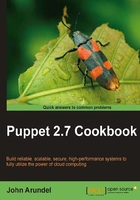
Producing automatic HTML documentation
"An expert is someone who is one page ahead of you in the manual."—David Knight
Like most engineers, I never read the manual, unless and until the product actually catches fire. However, as your manifests get bigger and more complex, it can be helpful to create HTML documentation for your nodes and classes using Puppet's automatic documentation tool, puppet doc.
How to do it…
Run puppet doc over your manifest as follows:
puppet doc --all --outputdir=/var/www/html/puppet --mode rdoc --manifestdir=/etc/puppet/manifests/

How it works…
puppet doc creates a structured HTML documentation tree in /var/www/html/puppet similar to that produced by RDoc, the popular Ruby documentation generator. This makes it easier to understand how different parts of the manifest relate to one another, as you can click on an included class name and see its definition.
There's more…
puppet doc will generate basic documentation of your manifests as they are at present. However, you can include more useful information by adding comments to your manifest files, using the standard RDoc syntax. Here's an example of some documentation comments added to a class:
class puppet {
# This class sets up the Puppet client.
#
# ==Actions
# Install a cron job to run Puppet.
#
# ==Requires
# * Package["puppet"]
#
cron { "run-puppet":
command => "/usr/sbin/puppet agent --test >/dev/null 2>&1",
minute => inline_template("<%= hostname.hash.abs % 60 %>"),
}
}
Your comments are added to the documentation for each class in the resulting HTML files as shown in the following screenshot:
